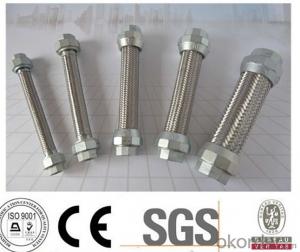Stainless Steel Braid Hose with Special Treatment
- Loading Port:
- Tianjin
- Payment Terms:
- TT OR LC
- Min Order Qty:
- 1000 pc
- Supply Capability:
- 100000 pc/month
OKorder Service Pledge
OKorder Financial Service
You Might Also Like
Item specifice
Stainless Steel Braid Hose with Special Treatment
Applications of Stainless Steel Braid Hose with Special Treatment:
--Refueling system
--Chemical and pharmaceutical industry
--Industrial hydraulic systems
--Air conditioners in industrial and construction –site vehicles
--Food and beverage industry
--Special and standard industrial applications
--Water and cleaning management
Features of Stainless Steel Braid Hose with Special Treatment:
1. )O. D.: 13-18MM 0.2-3M long
2. )Nut.: Nickel/Chrome Plated Brass (Zinc / Iron / Aluminum is available)
3. )Size Of Nut.: Female&Male 1/2''; 3/4''; 3/8''; 7/8''; 5/16'', and M10...
4. )Insert.: Brass (Zinc / Aluminum / Plastic is available)
5. )Inner tube.: Rubber/ EPDM/PVC
6. )Covered Material: Stainless Steel 201, 301, 304 /Aluminium Wire
7. )Working Pressure: 5Kg-15Kg
8. )Temperature: 0-92° C
9. )Quality Assurance: 3 years
RemarkAPPLICATION: HOUSEEHOLD WARE, BATHROOM WARE, SHOWER HOSE
PAYMENT: T/T, L/C
DELIVERY TIME: 20DAYS OR 30DAYS AFTER RECEIVED 30% DEPOSITS
MOQ: 5000PCS
ODM&OEM IS ACCEPTABLE
PackageInner: PP bag /Blister packing Outer: Carton box
Specifications of Stainless Steel Braid Hose with Special Treatment:
NO | I.D | Refer to O.D | Working pressure | Burst pressure | approximate Weight | |||||
(inch) | (mm) | (inch) | (mm) | MPa | Psi | MPa | Psi | kg/m | lbs/ft | |
1 | 1/8 | 3.2±0.2 | 0.35 | 9±0.3 | 2.06 | 300 | 8.27 | 1200 | 0.078 | 0.12 |
2 | 5/32 | 4±0.2 | 0.4 | 10±0.3 | 2.06 | 300 | 8.27 | 1200 | 0.092 | 0.14 |
3 | 3/16 | 4.8±0.2 | 0.43 | 11±0.3 | 2.06 | 300 | 8.27 | 1200 | 0.108 | 0.16 |
4 | 1/4 | 6.3±0.3 | 0.5 | 12.7±0.3 | 2.06 | 300 | 8.27 | 1200 | 0.134 | 0.2 |
5 | 5/16 | 8.0±0.3 | 0.56 | 14±0.3 | 2.06 | 300 | 8.27 | 1200 | 0.147 | 0.22 |
6 | 3/8 | 9.5±0.3 | 0.63 | 16±0.4 | 2.06 | 300 | 8.27 | 1200 | 0.182 | 0.27 |
7 | 15/32 | 12±0.3 | 0.75 | 19±0.5 | 2.06 | 300 | 8.27 | 1200 | 0.238 | 0.35 |
8 | 1/2 | 12.7±0.4 | 0.78 | 20±0.5 | 2.06 | 300 | 8.27 | 1200 | 0.262 | 0.39 |
9 | 5/8 | 16±0.4 | 0.94 | 24±0.5 | 1.03 | 150 | 4.12 | 600 | 0.351 | 0.52 |
10 | 3/4 | 19±0.4 | 1.13 | 28.8±0.5 | 1.03 | 150 | 4.12 | 600 | 0.515 | 0.77 |
11 | 1 | 25.4±0.5 | 1.38 | 35±0.6 | 1.03 | 150 | 4.12 | 600 | 0.637 | 0.95 |
Images of Stainless Steel Braid Hose with Special Treatment:
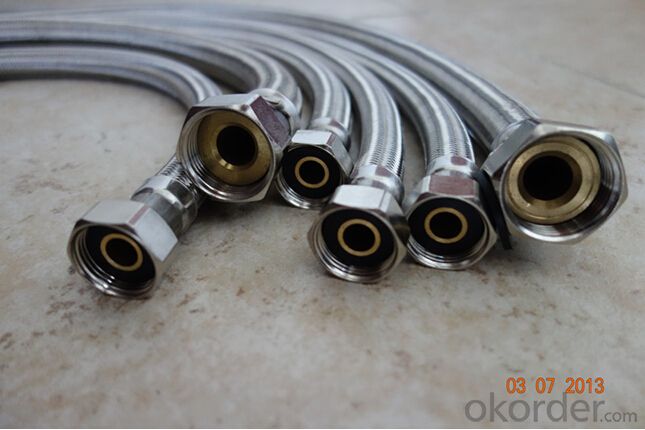
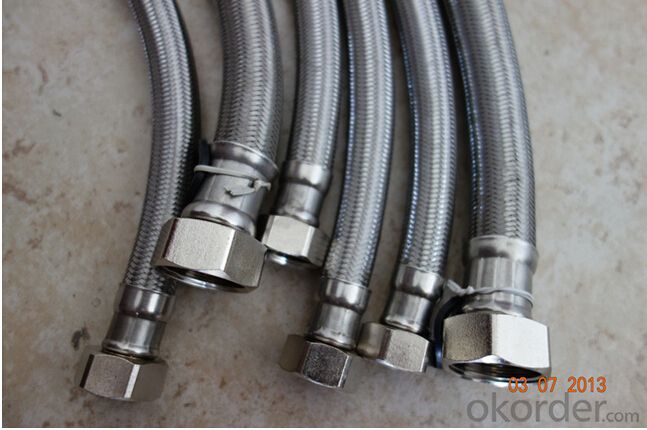
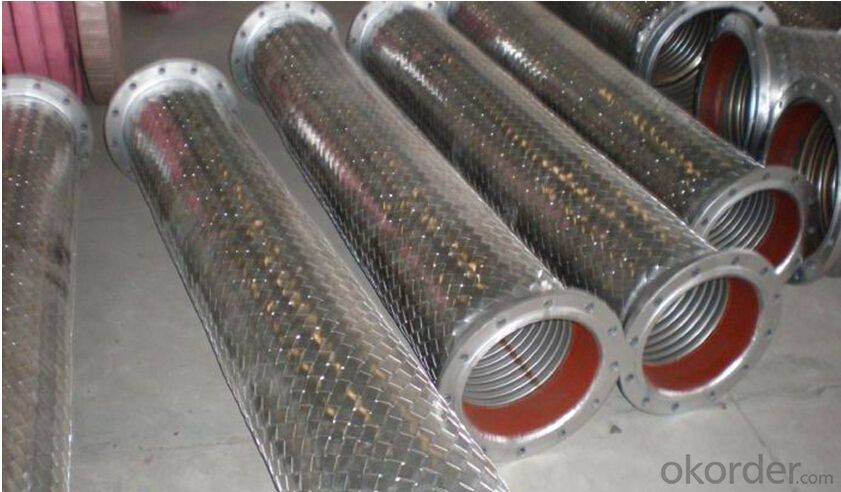
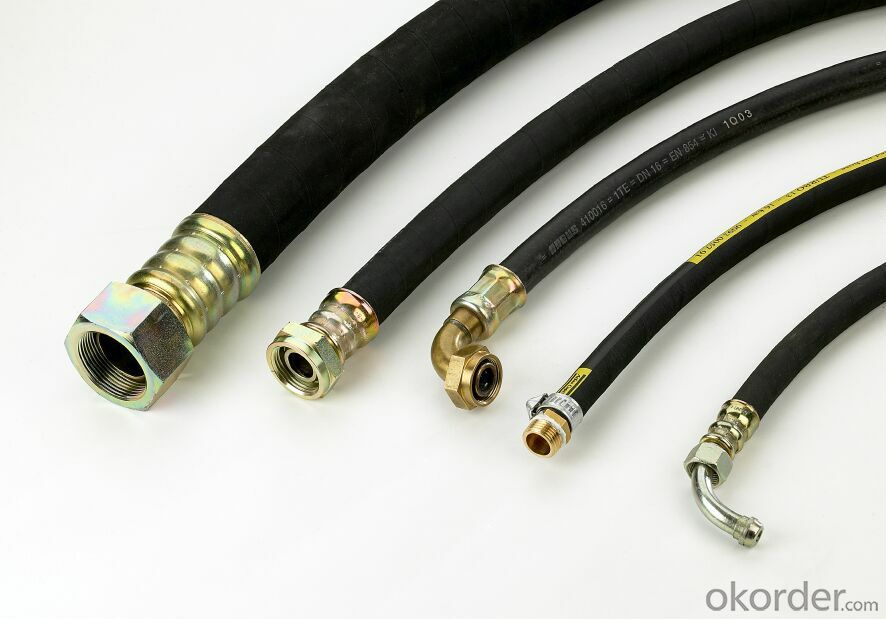
Package of Stainless Steel Braid Hose with Special Treatment:
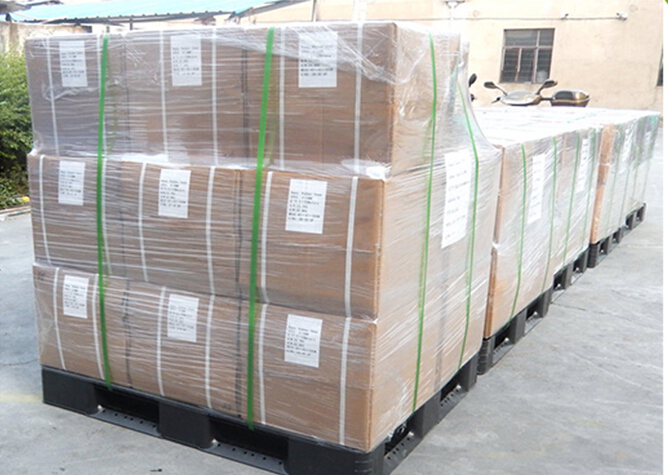
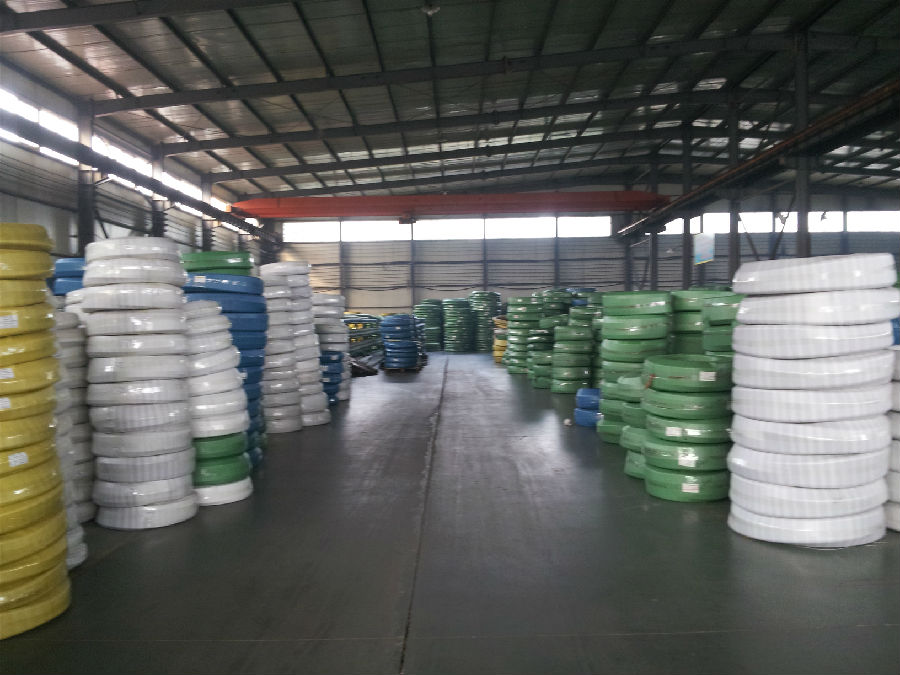
FAQ of Stainless Steel Braid Hose with Special Treatment:
Who we are:
Answer: We CNBM is a Chinese state-owned enterprise ranked 267th among the Global Fortune 500, as the largest building materials company,we have over 300 affiliated companies,and so many production lines and branch office distribute in China.
2. About our quality:
Answer: Every product needs to be quality proved before shipping.
3. About our service:
Answer: We could gurantte that we can reply you in 2 working hours.
- Q:Can stainless steel pipes be used for oil and gas refineries?
- Yes, stainless steel pipes can be used for oil and gas refineries. Stainless steel is a highly durable and corrosion-resistant material, making it suitable for the harsh and corrosive environments found in refineries. It can withstand high pressures, extreme temperatures, and exposure to various chemicals and corrosive substances commonly found in oil and gas operations. Additionally, stainless steel pipes offer excellent resistance to erosion, pitting, and cracking, ensuring the integrity and longevity of the pipeline system.
- Q:What are the maintenance requirements for stainless steel pipes?
- Compared to other materials, stainless steel pipes have relatively low maintenance requirements. However, to ensure their longevity and optimal performance, there are a few key steps that should be taken. To begin with, it is essential to regularly clean the pipes to remove any dirt, grime, or contaminants that may accumulate on the surface. This can be accomplished by using mild soap and water or a non-abrasive cleaner. It is crucial to avoid the use of abrasive materials or harsh chemicals as they can cause damage to the stainless steel surface. Periodically inspecting the pipes is also recommended to check for any signs of corrosion or damage. While stainless steel is known for its corrosion resistance, there are certain environments or conditions that can still make it susceptible. Addressing any signs of corrosion promptly is important to prevent further deterioration. Protecting the stainless steel pipes from physical damage or impact is another important factor. This can be achieved by avoiding heavy objects from hitting or rubbing against the pipes and using suitable padding or insulation in areas where they may be exposed to potential impact. Lastly, it is crucial to ensure that the stainless steel pipes are installed and used in accordance with their intended purpose and within their specified temperature and pressure limits. This will help prevent any unnecessary stress or strain on the pipes, which could result in premature failure. By adhering to these maintenance requirements, stainless steel pipes can offer long-lasting durability and performance in various applications.
- Q:Are stainless steel pipes resistant to abrasion?
- Stainless steel pipes possess remarkable resistance to abrasion, thanks to the exceptional characteristics of stainless steel, including its exceptional hardness and strength. Crafted from an alloy that comprises at least 10.5% chromium, stainless steel pipes are endowed with a protective coating on their surface, which efficiently thwarts rust and corrosion. This protective layer further aids in resisting abrasion, rendering stainless steel pipes an outstanding option for situations prone to intense wear and tear. Furthermore, stainless steel pipes exhibit remarkable heat resistance and durability, making them the perfect choice for industries like oil and gas, chemical, and construction.
- Q:What are the cost considerations for stainless steel pipes?
- The cost considerations for stainless steel pipes include the initial purchase price, installation costs, maintenance expenses, and potential long-term savings due to their durability and corrosion resistance. Additionally, factors such as the grade, size, and quantity of pipes needed and any additional fabrication or customization requirements can also impact the overall cost.
- Q:Can stainless steel pipes be insulated with cellulose?
- Yes, stainless steel pipes can be insulated with cellulose. Cellulose insulation is a common choice for insulating pipes due to its high thermal resistance and fire-resistant properties. It can be used on various types of pipes, including stainless steel. Cellulose insulation can be applied to the pipes using different methods, such as wrapping the pipes with cellulose insulation blankets or filling the pipe cavities with loose-fill cellulose insulation. Insulating stainless steel pipes with cellulose can help prevent heat loss, reduce energy consumption, and ensure the pipes maintain a consistent temperature.
- Q:Can stainless steel pipes be used for petrochemical plants?
- Yes, stainless steel pipes can be used for petrochemical plants. Stainless steel is highly resistant to corrosion, making it an ideal choice for petrochemical plants where corrosive substances are handled. These pipes are capable of withstanding high temperatures and pressures, making them suitable for the harsh operating conditions of petrochemical plants. Additionally, stainless steel pipes have excellent mechanical properties, which ensure their durability and reliability in such industrial environments. Moreover, stainless steel pipes are easy to clean and maintain, reducing the risk of contamination and facilitating efficient operations in petrochemical plants.
- Q:How do you prevent pressure loss in stainless steel pipes?
- To prevent pressure loss in stainless steel pipes, there are a few key measures that can be taken: 1. Proper pipe sizing: Ensure that the diameter of the stainless steel pipe is appropriate for the flow rate and pressure requirements of the system. Undersized pipes can result in increased pressure loss due to higher fluid velocities. 2. Minimize pipe length and bends: Keep the length of the stainless steel pipe as short as possible and reduce the number of bends or elbows. Longer pipes and multiple bends introduce friction and turbulence, leading to pressure loss. 3. Smooth interior surface: Use stainless steel pipes with a smooth interior surface finish. This helps to reduce frictional resistance and turbulence, thereby minimizing pressure loss. 4. Avoid unnecessary fittings and valves: Each fitting or valve in a stainless steel pipe system introduces additional pressure loss. Minimize the use of unnecessary fittings and valves, and opt for those with low resistance to maintain pressure. 5. Proper installation: Ensure that the stainless steel pipes are installed correctly, with proper alignment and support. Misaligned or poorly supported pipes can lead to excessive stress and potential deformation, causing pressure loss. 6. Regular maintenance and cleaning: Periodically inspect and clean the stainless steel pipes to remove any accumulated scale, debris, or deposits. Such obstructions can restrict flow and result in pressure loss. 7. Consider flow control devices: Depending on the application, incorporating flow control devices like flow restrictors, pressure regulators, or flow meters can help maintain optimal pressure levels in the stainless steel pipe system. By following these measures, pressure loss in stainless steel pipes can be minimized, ensuring efficient and effective fluid transportation within the system.
- Q:Can stainless steel pipes be used for irrigation sprinkler systems?
- Yes, stainless steel pipes can be used for irrigation sprinkler systems. Stainless steel is highly resistant to corrosion and rust, making it a durable choice for outdoor applications like irrigation systems. Additionally, stainless steel pipes have excellent strength and can withstand high-pressure conditions, making them suitable for sprinkler systems.
- Q:What is the difference between annealed and tempered stainless steel pipes?
- Both annealed and tempered stainless steel pipes undergo heat treatment to improve their properties, but they differ in terms of mechanical characteristics and applications. Annealed stainless steel pipes are made soft and ductile through the annealing process. This process involves heating the material to a high temperature and then slowly cooling it, relieving internal stresses and increasing flexibility. As a result, these pipes are easier to bend and shape. While annealed pipes have lower hardness and strength, they are more resistant to corrosion. On the other hand, tempered stainless steel pipes go through a different heat treatment called tempering. After quenching, the steel is reheated to a specific temperature and then rapidly cooled. This process enhances the steel's strength, hardness, and toughness, making it suitable for applications requiring high mechanical properties. Tempered pipes have greater hardness and strength, but their corrosion resistance may be slightly lower compared to annealed pipes. The choice between annealed and tempered stainless steel pipes depends on the specific application. Annealed pipes are commonly used in industries that prioritize excellent corrosion resistance and flexibility, such as the food processing, pharmaceutical, and chemical sectors. Conversely, tempered pipes are preferred in applications requiring greater strength and durability, like construction, automotive, and aerospace industries. In summary, annealed stainless steel pipes are softer and more flexible, offering better corrosion resistance. On the other hand, tempered stainless steel pipes are stronger and harder, with slightly reduced corrosion resistance. The appropriate type selection depends on the mechanical requirements and the environment in which the pipes will be used.
- Q:What is the difference between seamless and LSAW stainless steel pipes?
- The main difference between seamless and LSAW (Longitudinal Submerged Arc Welded) stainless steel pipes lies in their manufacturing process. Seamless stainless steel pipes are made by piercing a solid cylindrical billet and then rolling it into a pipe shape without any welding involved. On the other hand, LSAW stainless steel pipes are created by using a submerged arc welding process along the longitudinal seam of a steel plate. This welding process provides added strength and durability to the pipe. Both types of pipes have their own advantages and are used in different applications based on their specific characteristics.
1. Manufacturer Overview |
|
|---|---|
| Location | |
| Year Established | |
| Annual Output Value | |
| Main Markets | |
| Company Certifications | |
2. Manufacturer Certificates |
|
|---|---|
| a) Certification Name | |
| Range | |
| Reference | |
| Validity Period | |
3. Manufacturer Capability |
|
|---|---|
| a)Trade Capacity | |
| Nearest Port | |
| Export Percentage | |
| No.of Employees in Trade Department | |
| Language Spoken: | |
| b)Factory Information | |
| Factory Size: | |
| No. of Production Lines | |
| Contract Manufacturing | |
| Product Price Range | |
Send your message to us
Stainless Steel Braid Hose with Special Treatment
- Loading Port:
- Tianjin
- Payment Terms:
- TT OR LC
- Min Order Qty:
- 1000 pc
- Supply Capability:
- 100000 pc/month
OKorder Service Pledge
OKorder Financial Service
Similar products
New products
Hot products
Related keywords
